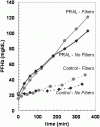Evaluation of a pumping assist lung that uses a rotating fiber bundle
- PMID: 16340367
- PMCID: PMC2002496
- DOI: 10.1097/01.mat.0000178970.00971.43
Evaluation of a pumping assist lung that uses a rotating fiber bundle
Abstract
A paracorporeal respiratory assist lung (PRAL) is being developed for supplemental gas exchange to allow the native lungs of acute lung failure patients to heal. The device consists of a rotating annular microporous hollow fiber membrane bundle. The rotation augments the gas exchange efficiency of the device at constant flow-rate thereby uncoupling gas exchange and flow rate. The rotating fibers also enable the PRAL to pump the blood without the need for an additional pump or arterial cannulation. Blood flow rates will be between 500 and 750 ml/min with CO(2) removal rates of 100-130 ml/min. A prototype was manufactured with an overall surface area of 0.25 m. When rotated at 1500 rpm, CO(2) removal increased by 133% and O(2) transfer increased by 157% during an in vitro bovine blood study. The pumping of the rotating fiber bundle was assessed in a glycerol/water solution. At 1500 rpm, the PRAL generated 750 ml/min against 52 mm Hg pressure. Hemolysis of the device was assessed using in vitro bovine blood from a slaughterhouse. Plasma free hemoglobin levels were similar regardless of whether the rotating fibers were present in the PRAL, indicating that a rotating fiber bundle can be used to increase gas exchange without causing blood trauma.
Figures







Similar articles
-
Fiber Bundle Design for an Integrated Wearable Artificial Lung.ASAIO J. 2017 Sep/Oct;63(5):631-636. doi: 10.1097/MAT.0000000000000542. ASAIO J. 2017. PMID: 28187049 Free PMC article.
-
Evaluation of fiber bundle rotation for enhancing gas exchange in a respiratory assist catheter.ASAIO J. 2007 May-Jun;53(3):368-73. doi: 10.1097/MAT.0b013e318031af3b. ASAIO J. 2007. PMID: 17515731 Free PMC article.
-
New design for a pumping artificial lung.ASAIO J. 1996 Sep-Oct;42(5):M615-9. doi: 10.1097/00002480-199609000-00061. ASAIO J. 1996. PMID: 8944954
-
Evaluation of a respiratory assist catheter that uses an impeller within a hollow fiber membrane bundle.ASAIO J. 2009 Nov-Dec;55(6):569-74. doi: 10.1097/MAT.0b013e3181bc2655. ASAIO J. 2009. PMID: 19779302
-
Design and evaluation of a new, low pressure loss, implantable artificial lung.ASAIO J. 1994 Jul-Sep;40(3):M522-6. doi: 10.1097/00002480-199407000-00055. ASAIO J. 1994. PMID: 8555571
Cited by
-
Physiological and Technical Considerations of Extracorporeal CO2 Removal.Crit Care. 2019 Mar 9;23(1):75. doi: 10.1186/s13054-019-2367-z. Crit Care. 2019. PMID: 30849995 Free PMC article. Review.
-
Fiber Bundle Design for an Integrated Wearable Artificial Lung.ASAIO J. 2017 Sep/Oct;63(5):631-636. doi: 10.1097/MAT.0000000000000542. ASAIO J. 2017. PMID: 28187049 Free PMC article.
-
Bench Validation of a Compact Low-Flow CO2 Removal Device.Intensive Care Med Exp. 2018 Sep 24;6(1):34. doi: 10.1186/s40635-018-0200-7. Intensive Care Med Exp. 2018. PMID: 30251223 Free PMC article.
-
Thirty-day in-vivo performance of a wearable artificial pump-lung for ambulatory respiratory support.Ann Thorac Surg. 2012 Jan;93(1):274-81. doi: 10.1016/j.athoracsur.2011.08.076. Epub 2011 Nov 25. Ann Thorac Surg. 2012. PMID: 22115337 Free PMC article.
-
A biohybrid artificial lung prototype with active mixing of endothelialized microporous hollow fibers.Biotechnol Bioeng. 2010 Jun 15;106(3):490-500. doi: 10.1002/bit.22675. Biotechnol Bioeng. 2010. PMID: 20091735 Free PMC article.
References
-
- Data and statistics. American Lung Association; 2004. [February 2005]. Available at: http://www.lungusa.org/site/pp.asp?c=dvLUK9O0E&b=33347.
-
- Demling RH. The modern version of adult respiratory distress syndrome. Ann Rev Med. 1995;46:193–202. - PubMed
-
- Zilberberg MAD, Epstein SK. Acute lung injury in the medical ICU: Co‐morbid conditions, age, etiology, and hospital outcome. Am J Respir Crit Care Med. 1998;157:1159–1164. - PubMed
-
- Halbert RJ, Isonaka S, George D, Iqbal A. Interpreting COPD prevalence estimates: what is the true burden of disease? Chest. 2003;123:1684–1692. - PubMed
-
- Hirvela ER. Advances in the management of acute respiratory distress syndrome: Protective ventilation. Arch Surg. 2000;135:126–135. - PubMed
Publication types
MeSH terms
Substances
Grants and funding
LinkOut - more resources
Full Text Sources
Other Literature Sources

